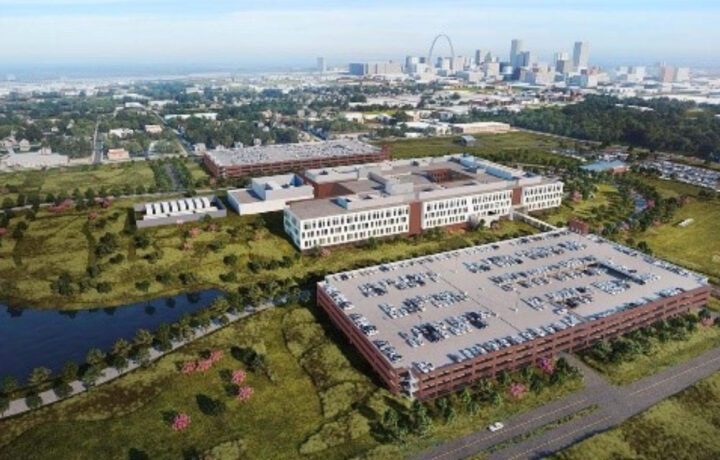The National Geospatial-Intelligence Agency (NGA) is headquartered at Fort Belvoir in Springfield, VA. Its 2,300,000-square-foot (210,000-square-meter) facility is currently the third-largest government building in the Washington metropolitan area after the Pentagon and Ronald Reagan Building. In addition, NGA, which serves as a combat support agency within the U.S. DoD, also operates another facility in St. Louis, MO, one that it has outgrown.
The current NGA Campus West (NCW) will be replaced by a new 700,000-square-foot office building that will also include two parking garages, a visitor center, a delivery inspection facility, and a more secure entrance/exit. The current timeline calls for the N2W project, located in the historic St. Louis Place neighborhood, to open this September.
The 3,150 NGA employees will complete the move from the current Soulard, St. Louis, location to the Next NGA West, which will be completed next year.
“Next NGA West will deliver a modern, flexible and collaborative facility in support of the National Geospatial-Intelligence Agency’s evolving geospatial intelligence mission, offering open and innovative partnering spaces, advanced technology solutions, and a sustainable environment that serves the Agency’s mission and employees for the next 100 years,” NGA explained on its website.
This will modernize the agency’s footprint in the Midwest and serve as a second hub for geospatial intelligence operations.
Key Features of the N2W Move
According to NGA, the new $1.7 billion N2W (Next NGA West) will feature more employee-focused amenities, including a modern cafeteria, fitness center, quiet areas, and dedicated meeting spaces. The open facility will also promote collaborative partnerships and include a learning center and spaces for education forums and academic events.
The building has received a Leadership in Energy and Environmental Design (LEED) Silver certification for using “healthy materials.” It is surrounded by a “green campus of trees and grassy areas mixed with sustainable local prairie fields and walking paths.” The garage parking should support 90% of the NGA workforce’s vehicles.
The new N2W was first announced in 2016. It has received support from local and regional officials and promises to help transform St. Louis into a national center for geospatial science technology.
On Track and on Budget
Earlier this month, NGA director Vice Adm. Frank Whitworth confirmed that the target date has not changed while the project has remained on track amid budget pressures and workforce reductions following directives to cut government waste in the second Trump Administration.
“We have been giving tours to our workforce. They’re getting excited,” Whitworth told lawmakers during testimony before the House Armed Services Committee’s strategic forces subcommittee last week. He said the N2W project was “One of the best examples of the combination of business, academia, civil government, federal government, intelligence, all banding together to ensure that this is a success.”
Fostering Greater Innovation and Collaboration
Whitworth further suggested that the N2W facility will foster greater innovation and collaboration between the federal government, academia, and the private sector. He highlighted the importance of space-based systems, which allowed NGA to fulfill its mission of delivering geospatial intelligence data for national security.
“Gathering the data and imagery necessary to characterize the activities and operations of our adversaries from the earth to space, is not a simple task,” Whitworth acknowledged.
That includes Geospatial intelligence (GEOINT), which Space News explained “refers to the use of imagery, maps, and other location-based data to understand activities and physical environments on Earth. It supports everything from military planning to emergency response and commercial logistics.”
While NGA personnel operate with military and intelligence teams in more than 20 countries, the agency has also forged a partnership with the United States Space Force, the sixth and newest branch of the U.S. military. That has included the creation of a joint mission management center, which can further streamline coordination and help close the gap between data collection and actionable insights, Space News added.
St. Louis, a DoD Boom Town?
St. Louis first became a center for aircraft and later spacecraft during the Second World War and the Cold War, with companies such as McDonnell Douglas playing a key role.
Boeing continues to operate the former McDonnell Douglas facilities, producing the F-15EX Eagle II fighter for the United States Air Force and the F/A-18 Super Hornet for the U.S. Navy. The future F-47, the sixth-generation fighter at the center of the Air Force’s Next Generation Air Dominance (NGAD) program, will likely be built in St. Louis. The aerospace firm also completes assembly of its MQ-25 unmanned refueling drones at its facilities north of St. Louis. In addition, the company recently invested $200 million to build a new factory in Mascoutah in the city’s metro east.




